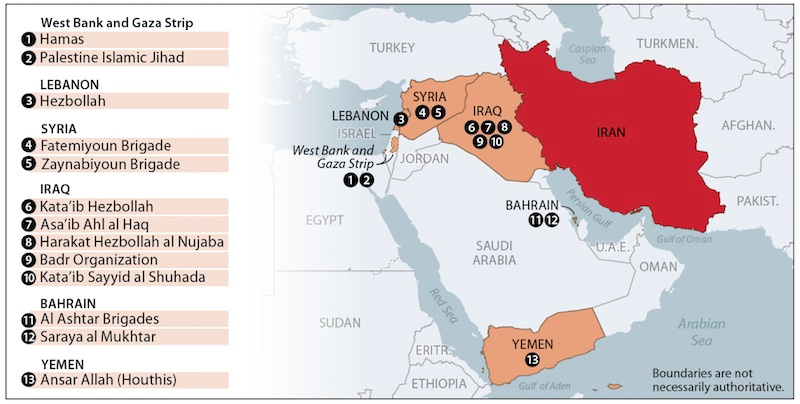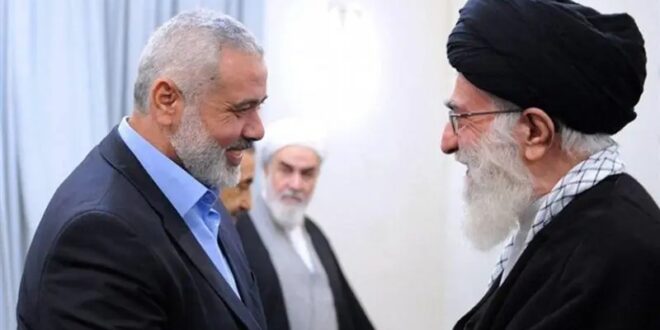Iran has long backed a network of armed groups in the Middle East to advance its regional interests. These groups, which include U.S.-designated Foreign Terrorist Organizations (FTOs) and which sometimes style themselves the “Axis of Resistance,” have conducted attacks on U.S., Israeli, and other targets for years. The number, pace, and scope of such attacks have surged since the October 7, 2023, Hamas-led assault on Israel from Gaza and in the context of the subsequent Israel-Hamas war.
The escalation of those attacks (including a January 2024 Iraqi militia attack that killed three U.S. servicemembers in Jordan) elevates the risk that these groups might trigger the direct U.S.-Iran military confrontation that both countries’ governments say they seek to avoid. U.S. policymakers may evaluate various means of deterring and responding to such attacks (such as diplomacy and/or military strikes, whether on militia groups, Iranian personnel abroad, or inside Iran), and potential benefits, costs, and unintended consequences of these options.
Iran’s Foreign Policy
Support for regional nonstate actors has been a pillar of the Iranian government’s foreign policy since the 1979 founding of the Islamic Republic. Iran supports these groups to advance its foreign policy aims, including to position itself as the defender of Shia Muslim communities and other groups that the Iranian government characterizes as oppressed, such as the Palestinians. Perhaps preeminent among these aims is reducing threats that Iran may face stemming from the regional influence of the United States and its regional allies, with which the Iranian government “sees itself as locked in an existential struggle,” according to a public assessment by the U.S. intelligence community.
Support for these groups carries strategic benefits and risks for Iran. Iranian leaders might see supporting armed groups as a cost-effective way to project power, given that Iran lacks some key conventional military capabilities. Sponsorship of actors abroad could also deter potentially regime-destabilizing attacks on Iran itself, as part of what some Iran experts call a “forward defense” strategy.
The sometimes-opaque nature of Iranian support for these groups may allow Iran to seek to deny its responsibility for its beneficiaries’ actions. At the same time, the United States and others may still seek to hold Iran accountable, including for actions that Iran may not have specifically directed or approved in advance. The Qods Force (QF) of Iran’s Islamic Revolutionary Guards Corps (IRGC) coordinates Iranian support to armed groups abroad; both the IRGC and IRGC-QF are designated for U.S. sanctions under terrorism-related authorities.
Selected Iran-Backed Groups
According to U.S. officials, the groups profiled below are prominent beneficiaries of Iranian government support. The nature and degree of Iranian support vary: while all share some key interests with Tehran, to differing extents they also may act independently in pursuit of their own interests.
Lebanese Hezbollah
Arguably the most powerful Iranian-backed group and a key player in Lebanese politics, Hezbollah (“Party of God,” alt. Hizballah) most closely represents an Iranian proxy, in the sense of aligning directly with, and acting on behalf of, Tehran. Founded in the context of the Lebanese civil war and Israeli invasion, Hezbollah was established in 1982 by Lebanese Shia militants who were inspired by, and received critical assistance from, the new Islamic Republic of Iran. Per the State Department, Iran “continues to provide Hizballah with most of its funding, training, weapons, and explosives, as well as political, diplomatic, monetary, and organizational aid.” Hezbollah attacked U.S. targets in Lebanon during the country’s civil war, and has since targeted Israeli and Jewish targets in several countries.
Hezbollah and Israel (which fought an inconclusive 34-day war in 2006) have periodically exchanged fire across Israel’s northern border since October 2023, raising fears of a broader escalation in which Hezbollah’s arsenal of some 150,000 missiles and rockets could threaten Israeli strategic sites and population centers. Israeli officials have threatened wider military action in Lebanon if Hezbollah does not withdraw from the border to permit tens of thousands of evacuated Israelis to return to their homes; Hezbollah has insisted that Israel first halt fighting in Gaza. Hezbollah has not attacked U.S. forces in the context of ongoing regional tension. Hezbollah has reportedly provided support to many of the groups below, including Hamas and the Houthis.
Hamas
Iran has backed the Sunni Islamist Palestinian group Hamas for decades, going back nearly to the group’s inception in the late 1980s. Since Hamas took de facto control of the Gaza Strip in 2007, it has engaged in several rounds of conflict with Israel, with continued material and financial support from Iran. The State Department assesses that Iran provides “up to $100 million annually in combined support to Palestinian terrorist groups, including Hamas.” Hamas has reportedly received additional material support from private entities in other regional countries, and has also secured resources via its governance of Gaza.
U.S. officials have stated publicly that they do not have evidence that Iran played a direct role in planning or carrying out the October 7 assault. Still, the Biden Administration contends that Iran is “broadly complicit in these attacks,” as Hamas’s “primary backer for decades.” Media accounts, citing unnamed U.S. and other officials, have differed in their assessments, with some indicating that Tehran may have been surprised by the attacks.
The Houthis
The Iranian government has long backed the Yemeni Shia militant group Ansar Allah, aka the Houthi movement, and has increased its support since the Houthis took control of Yemen’s capital and much of the north in 2014-2015. Iran’s support to the Houthis—including ballistic and cruise missiles, as well as unmanned weapons systems—has reportedly enabled the group to attack the territories of U.S. partner states, including Saudi Arabia and the United Arab Emirates.
The Houthis have espoused categorically anti-Israel views for decades, and since October 2023 have claimed several missile attacks against Israel, with many intercepted by Israeli or U.S. forces. The Houthis assert that they are demonstrating solidarity with the Palestinians by conducting attacks on commercial and naval vessels in the Red Sea since November 2023. These attacks have compelled many international shipping companies to abandon that waterway in favor of lengthier, costlier routes. The United States has deployed military assets to the region to respond to the Houthi attacks, thwarting Houthi hijackings of commercial vessels and exchanging fire with Houthi forces. A series of U.S. airstrikes since January 11, 2024, opened what U.S. officials reportedly foresee as a potentially sustained campaign to degrade Houthi capabilities, with likely implications for U.S.-backed efforts to end the civil war and meet humanitarian needs in Yemen.
Iraqi Militias
Iran has deeply rooted ties in neighboring Iraq, where it backs a number of powerful military and political groups, mostly from Iraq’s Shia majority. These groups gained combat experience and deepened their ties with Iran during operations against the Islamic State (IS) starting in 2014, and have leveraged that experience to become prominent actors in Iraq’s political system. Since 2017, Iran-backed Iraqi groups have conducted attacks against U.S. forces in Iraq and Syria, to which the United States has periodically responded with airstrikes. U.S.-designated FTOs in Iraq linked to such attacks include Kata’ib Hezbollah (KH), Harakat al Nujaba (HN), and Asa’ib Ahl al Haq (AAH).
Attacks by those groups on U.S. forces in Iraq and Syria have multiplied since October 2023, prompting U.S. strikes, including a January 2024 airstrike in Baghdad that killed a senior HN leader. In response, the Iraqi government has sought to end the U.S.-led counter-IS coalition presence in the country, with potential implications for U.S. counter-IS operations in Syria. In January 2024, an attack claimed by Iran-backed Iraqi militants killed 3 U.S. servicemembers at a base in Jordan, the first U.S. military fatalities from strikes in the region after October 2023.

Source: Created by CRS, based on U.S. Department of State, Country Reports on Terrorism, and other public sources.
U.S. Policy
The Biden Administration has sought to deter and respond to potentially escalatory attacks from Iran-backed groups, while also avoiding the regionalization of the Israel-Hamas war beyond Gaza. Iranian officials have stated support for attacks as a means of ending the war in Gaza, while denying that they control the groups carrying out those attacks. Officials from each country have stated that private messages have been relayed to the other regarding an intention to avoid wider war.
Some Members of Congress have supported the Administration’s actions to date. Others have called for direct U.S. strikes on Iran, claiming that operations elsewhere do not deter Iran or the groups it supports. Others assert that the Administration lacks congressional authorization for U.S. forces to target Iran-backed groups.
The U.S. military has struck Iranian assets and personnel abroad (e.g., the 2020 strike that killed then-IRGC-QF commander Qasem Soleimani) but has not claimed any strikes within Iran. A broader military conflict with Iran could entail major costs for the United States, and may cause Iran to accelerate its nuclear activities or target U.S. forces and/or partners.
 Eurasia Press & News
Eurasia Press & News


